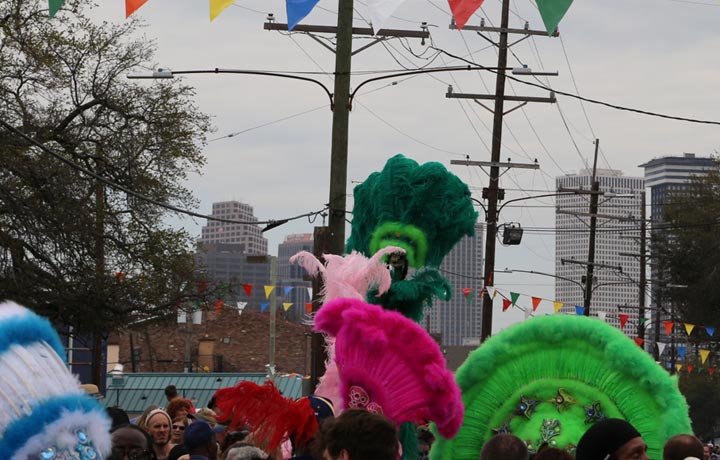Mardi Gras Indian tribes are among the most fascinating and mysterious of New Orleans’ cultural phenomena.
The origins of the Mardi Gras Indians are not entirely clear, but Chief Becate of the Creole Wild West tribe is considered the originator for masking as an Indian during a Mardi Gras in the 1880s. Scholars also credit the Native Americans who came to perform in New Orleans with the Buffalo Bill Wild West Show in 1884 for giving locals inspiration. Others believe that a connection between blacks and Native Americans was forged when New Orleans escaped slaves found asylum with Louisiana tribes. Indeed, Chief Becate is thought to have been part Native American.
Mardi Gras Indian Costumes
The Mardi Gras Indians take costuming more seriously than anyone else during Mardi Gras. Their unforgettable and fantastic hand-sewncostumes are creations of intricate beadwork and artistic imagery which rank among the nation’s best folk art. Worn just once, the costumes take an entire year to create, with hundreds of thousands of beads, brightly dyed ostrich plumes, sequins, velvet and rhinestones sewn on by hand – some weighing as much as 150 pounds!
Mardi Gras Indian Music
Music, typically chanting with tambourines and other handheld percussion, plays a central role in the Mardi Gras Indian spectacle, but the members of a few tribes—the Wild Magnolias and the Wild Tchoupitoulas in particular—have released critically acclaimed recordings and many times perform professionally with a full band.
Mardi Gras Indian music has also permeated into New Orleans funk, soul and R&B. The famous New Orleans tune “Iko Iko” with the lyrics, “My flag boy and your flag boy, sitting by the fire,” is rooted in Mardi Gras Indian tradition as is the New Orleans standard “Hey Pocky Way.”
Mardi Gras Indian Tribes
There are more than 50 Indian tribes in the city and each march to the beat of their own drummer, literally. With a formal hierarchy of chiefs, spy boys, flag boys, big chiefs, wild men and other unique monikers, the Indians grace the streets of New Orleans’ neighborhoods in friendly competition over which chief is the “prettiest.” With boastful singing and threatening dances and gestures, on Mardi Gras Day the tribes go out seeking other tribes to do “battle” with. In earlier days, a meeting of tribes often turned violent, and few others would dare to be present. Now, plenty of spectators come out to watch Indian tribes who compete by costume and song one-upmanship. Indians are organized into roughly three dozen tribes with names like the Golden Eagles, the Flaming Arrows, the Yellow Pocahontas, and the Bayou Renegades.

